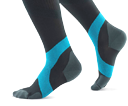| Where to Start with Compression Stockings26 February 2024 | Alex If you know that you need a pair of compression stockings or compression tights but aren't sure which are the right type for you, you have come to the right place! Here at CompressionStockings.co.uk, we've put together a guide on Where to Start with Compression Stockings, comprising of our helpful tips to find the perfect pair. What's Covered in This Guide?
Before You Do Anything, Visit Your DoctorThis may sound like a bit of a cop-out on our part, but there really is no replacement for a professional medical examination when it comes to knowing which stockings are right for you. Without being looked over by a professional, it is impossible for us to gauge the severity of your condition and the last thing that we want is to supply anyone with stockings that aren't right for their needs. Once you have visited the doctor, they will likely give you a pair (or a few pairs) of stockings to wear. Lots of our customers feel as though they are not given as many pairs of stockings as they would like, or that the hosiery that they are given isn't to their taste. This is where CompressionStockings.co.uk can really help – we've got a wide selection of medical-grade compression from some of the top suppliers in the market, helping you to find a pair better suited to your needs. Shopping by the Level of Compression You RequireOne of the most confusing (and one of the most vital) parts of selecting your stockings is making sure that they are the right compression class. The class indicates how much compression is provided to your legs, and is usually graduated, meaning that the stockings provide more compression at the bottom than they do at the top (e.g. you might see stockings listed as having 23 - 32mmHg of compression, which shows the range of compression provided.
RAL and AFNOR Compression ClassesThere are two main scales that are used to measure compression – RAL and AFNOR. To cut a long (and boring) story short, RAL is used in most of Europe apart from France, where AFNOR is preferred. As we have suppliers from all over Europe, unfortunately we have some garments that are measured in AFNOR and some that are measured in RAL. We do NOT recommend guessing which level of compression is right for your needs; we recommend always visiting a medical professional to get expert information on the correct level for your needs. Finding Your Strength on Our SiteTo find all of our stockings in your required strength, simply click the links below:
Shopping for a Specific Range?Sometimes the wheel doesn't need to be reinvented – if you've got a type of stocking that you wear and that you are happy with, then it's good to stick with that. Here at CompressionStockings.co.uk, we have split our ranges out into the different models and brands. Making it easier for you to find your perfect pair. See our customer's favourite models below: Sigvaris
JOBST
Medi Which Length of Compression Stockings Do I Need?For a lot of the styles that we sell, there are different length options available. While this can differ from manufacturer to manufacturer, the most common lengths are: What Are the Differences Between the Lengths?
Open vs Closed Toe: Which One Is Right for Me?Many of our socks are available with a closed-toe design or an open-toe design and for the uninitiated, it can be difficult to know what the difference between these two styles is. Both open- and closed-toe stockings provide the same level of compression and support to your feet. The difference between the two styles is based on personal preference: some people find that open-toed stockings are more comfortable (as they have higher breathability), and they can also be used with peep-toe shoes. On the other hand, if you find that your feet are often cold, the closed-toe option is probably better for you. Anti-Embolism and Hospital SocksFor a lot of people, their first encounter with compression stockings or compression socks comes when they are hospitalised. Due to the fact that when you are in hospital you are less active, there is a higher risk of blood clots and DVT occurring. To help counter this, a lot of hospitals provide their patients with compressive anti-embolism socks. While the stockings that you are supplied with may differ based on your location, we stock two of the most commonly-used brands of hospital socks: Covidien TED Stockings and FitLegs. What Is the Benefit of Using Hospital Socks After I've Been Discharged?If you have a condition or have had a surgery that affects your mobility, you may be at risk of developing deep vein thrombosis (DVT). Wearing compressive socks can help to lower this risk, even once you are out of hospital and on the mend. We recommend speaking to your doctor or surgeon about how long you should wear your stockings for after surgery – please note that compressive socks are not recommended for all conditions. Wearing Compression Socks for FlightsWhile most people love going away to some far-flung destination for holiday, what's not so great is the effect that a long flight can have on your legs. While making sure that you stand up and stretch your legs will cut it for a lot of people, the right pair of flight socks can do wonders to reduce your risk of developing DVT or blood clots when sitting in your seat. Click here to see our full range of travel socks.Should I Wear Flight Socks?For flights with a duration of over four hours, the following can put you at risk for developing a blood clot:
At the end of the day, if you are unsure about whether or not you would benefit from using travel socks, we recommend getting the opinion of a medical professional.
We hope that this guide has left you with a better understanding of how to find your perfect pair of compression stockings than you initially had. For a wealth of information about our brands and about compression garments in general, please check out our full blog area. |







